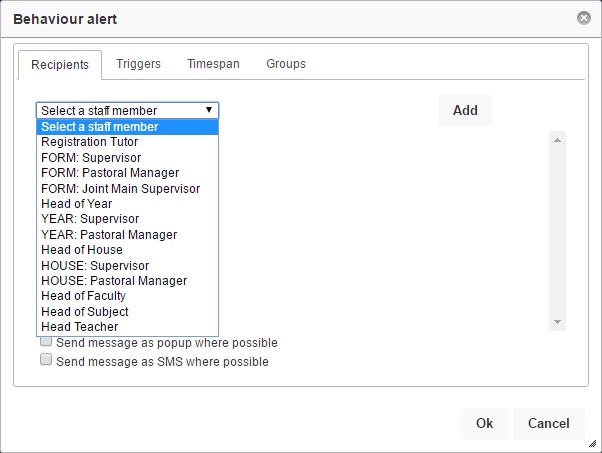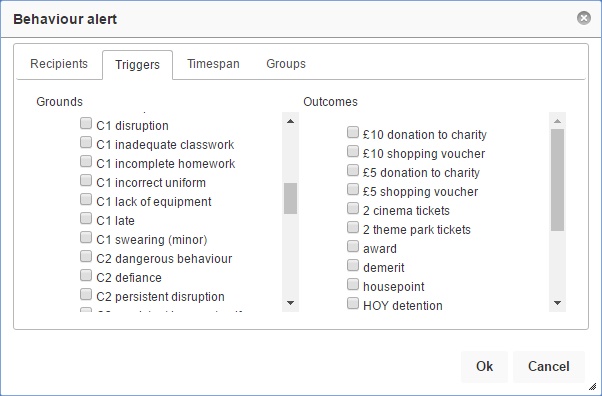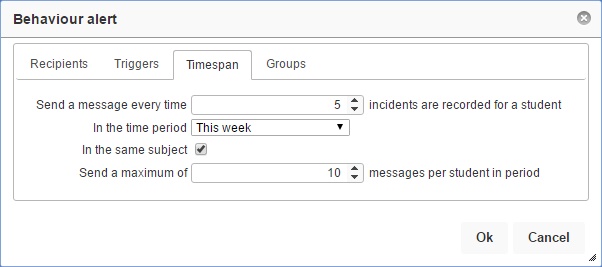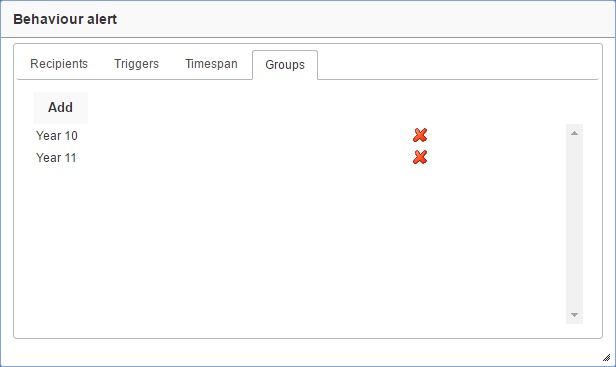Difference between revisions of "Configure alerts"
(Created page with "{{permissions|Behaviour|Access ___ behaviour incidents|Allow user to access the configure alerts screen}} You can notify staff of behaviour information as soon as it happens ...") |
m (→Timespan) |
||
| (10 intermediate revisions by one other user not shown) | |||
| Line 1: | Line 1: | ||
{{permissions|Behaviour|Access ___ behaviour incidents|Allow user to access the configure alerts screen}} | {{permissions|Behaviour|Access ___ behaviour incidents|Allow user to access the configure alerts screen}} | ||
| − | You can notify staff of behaviour information as soon as it happens using PARS. Behaviour alerts are used to trigger a [[notice]] to one or more members of staff whenever certain behaviours are recorded for pupils. If you need another staff member to action a behaviour incident instead of just knowing about it, then you should use [[behaviour referrals]] not behaviour alerts. <br> <br> | + | You can notify staff of behaviour information as soon as it happens using PARS. Behaviour alerts are used to trigger a [[Homepage#Notices|notice]] to one or more members of staff whenever certain behaviours are recorded for pupils. If you need another staff member to action a behaviour incident instead of just knowing about it, then you should use [[behaviour referrals]] not behaviour alerts. <br> <br> |
This page is accessed via: <br> | This page is accessed via: <br> | ||
| Line 18: | Line 18: | ||
===Recipients=== | ===Recipients=== | ||
| − | [[Image: | + | [[Image:confalerts004.jpg]] <br> <br> |
| − | First you should choose the recipients of your alert - do this by clicking the drop-down to see a list of available staff. If you want to add a specific member of staff then choose "Select a staff member". Otherwise, select one of the 'staff types', e.g. Form tutor, Head of Year. If you choose a staff type then when a pupil triggers the alert, a [[notice]] will be sent to the correct staff member for that pupil i.e. a pupil in year 9 would trigger an alert being sent to the Head of Year 9. <br> <br> | + | First you should choose the recipients of your alert - do this by clicking the drop-down to see a list of available staff. If you want to add a specific member of staff then choose "Select a staff member". Otherwise, select one of the 'staff types', e.g. Form tutor, Head of Year. If you choose a staff type then when a pupil triggers the alert, a [[Homepage#Notices|notice]] will be sent to the correct staff member for that pupil i.e. a pupil in year 9 would trigger an alert being sent to the Head of Year 9. <br> <br> |
Once you have selected your recipient, click "Add". You can add multiple recipients this way if you wish. There is also a tickbox at the bottom of the window that allows you to specify if the notice should pop-up on the recipients screen when they receive it. This is generally not recommended when teaching staff are recipients, as they may have their register on the whiteboard. The behaviour alert would then pop-up in front of their class. <br> <br> | Once you have selected your recipient, click "Add". You can add multiple recipients this way if you wish. There is also a tickbox at the bottom of the window that allows you to specify if the notice should pop-up on the recipients screen when they receive it. This is generally not recommended when teaching staff are recipients, as they may have their register on the whiteboard. The behaviour alert would then pop-up in front of their class. <br> <br> | ||
| Line 34: | Line 34: | ||
Finally you should select the timespan for your alert. This tab defines how often the pupils must be rewarded/reprimanded in order for an alert to be sent. <br> <br> | Finally you should select the timespan for your alert. This tab defines how often the pupils must be rewarded/reprimanded in order for an alert to be sent. <br> <br> | ||
| − | [[Image:confalerts04.jpg]] <br> <br> | + | [[Image:confalerts04.1.jpg]] <br> <br> |
'''Send a message every time''' <br> | '''Send a message every time''' <br> | ||
| Line 41: | Line 41: | ||
'''In the time period''' <br> | '''In the time period''' <br> | ||
This is the amount of times a pupil has to receive the number of behaviour incidents set in the option above, in order to trigger the alert. For example - you want an alert to be sent every time 10 incidents are recorded. Is it 10 in a week? Or a month? Or the whole year? <br> <br> | This is the amount of times a pupil has to receive the number of behaviour incidents set in the option above, in order to trigger the alert. For example - you want an alert to be sent every time 10 incidents are recorded. Is it 10 in a week? Or a month? Or the whole year? <br> <br> | ||
| + | |||
| + | '''In the same subject''' <br> | ||
| + | If this option is selected then the alert will only trigger when the pupil has accumulated the behaviour incidents in a single subject. This is mainly used to create alerts that notify Heads of Department. If this has been ticked, then an additional "All teachers of subject" choice will appear in the Recipients dropdown menu in the first tab.<br> <br> | ||
'''Send a maximum of ___ messages per student in period''' <br> | '''Send a maximum of ___ messages per student in period''' <br> | ||
| − | This options sets an upper limit of the number of [[notices]] that will be sent by the alert, within the time period specified above. <br> <br> | + | This options sets an upper limit of the number of [[homepage#notices|notices]] that will be sent by the alert, within the time period specified above. <br> <br> |
| + | |||
| + | ===Groups=== | ||
| + | |||
| + | You can add a list of student groups that the behaviour alert applies to. Only students from these groups will trigger the alert. <br> <br> | ||
| + | |||
| + | [[Image:alert_groups.jpg]] <br> <br> | ||
==Deleting alerts== | ==Deleting alerts== | ||
| Line 51: | Line 60: | ||
[[Category:Behaviour]] | [[Category:Behaviour]] | ||
[[Category:Communications]] | [[Category:Communications]] | ||
| − | |||
[[Category:Configuration]] | [[Category:Configuration]] | ||
Latest revision as of 15:06, 10 February 2023
| Permissions required to access this module: | |
| Section: | |
| Behaviour | |
| Permission(s): | |
| Access ___ behaviour incidents | |
| Allow user to access the configure alerts screen | |
You can notify staff of behaviour information as soon as it happens using PARS. Behaviour alerts are used to trigger a notice to one or more members of staff whenever certain behaviours are recorded for pupils. If you need another staff member to action a behaviour incident instead of just knowing about it, then you should use behaviour referrals not behaviour alerts.
This page is accessed via:
PARS main menu > Behaviour > Configure > Configure alerts
Contents
The configure alerts page
The configure alerts page will show you all of the alerts that you currently have configured, including information about the recipients, the message that will be sent and the triggers for the alert.
Adding and editing alerts
To create a new alert, click the "Add" button from the top toolbar. You can also click "Edit" to amend an existing alert - the process for both of these functions is the same. After you click either button, the window below will open. There are three tabs in the window: Recipients, Triggers and Timespan.
Recipients
First you should choose the recipients of your alert - do this by clicking the drop-down to see a list of available staff. If you want to add a specific member of staff then choose "Select a staff member". Otherwise, select one of the 'staff types', e.g. Form tutor, Head of Year. If you choose a staff type then when a pupil triggers the alert, a notice will be sent to the correct staff member for that pupil i.e. a pupil in year 9 would trigger an alert being sent to the Head of Year 9.
Once you have selected your recipient, click "Add". You can add multiple recipients this way if you wish. There is also a tickbox at the bottom of the window that allows you to specify if the notice should pop-up on the recipients screen when they receive it. This is generally not recommended when teaching staff are recipients, as they may have their register on the whiteboard. The behaviour alert would then pop-up in front of their class.
Triggers
On the triggers tab you need to select the behaviour incidents that will trigger an alert. You have a list of grounds on the left and a list of outcomes on the right. Tick all of the grounds and outcomes that you would like to trigger an alert. If you select both grounds and outcomes, then an alert will only be triggered if a behaviour incident is recorded with one of the grounds you selected and one of the outcomes at the same time.
Timespan
Finally you should select the timespan for your alert. This tab defines how often the pupils must be rewarded/reprimanded in order for an alert to be sent.
Send a message every time
This is the number of behaviour incidents a pupil must receive to trigger the alert. For example, you might want the form tutor to be notified if a pupil in their form receives 10 positive incidents in a week, so you would enter 10 here.
In the time period
This is the amount of times a pupil has to receive the number of behaviour incidents set in the option above, in order to trigger the alert. For example - you want an alert to be sent every time 10 incidents are recorded. Is it 10 in a week? Or a month? Or the whole year?
In the same subject
If this option is selected then the alert will only trigger when the pupil has accumulated the behaviour incidents in a single subject. This is mainly used to create alerts that notify Heads of Department. If this has been ticked, then an additional "All teachers of subject" choice will appear in the Recipients dropdown menu in the first tab.
Send a maximum of ___ messages per student in period
This options sets an upper limit of the number of notices that will be sent by the alert, within the time period specified above.
Groups
You can add a list of student groups that the behaviour alert applies to. Only students from these groups will trigger the alert.
Deleting alerts
To delete a behaviour alert, simply highlight it and click the "Delete" button from the top toolbar. This will not affect any behaviour incidents or notices that have already been sent, and will only stop future notices being sent.




